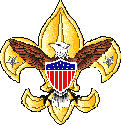| MERIT BADGES |
|
|
|
|
| Note: Eagle Required are in Italics |
"A"
American
Business
American Culture
American Heritage
American Labor
Animal Science
Archaeology
Archery
Architecture
Art
Astronomy
Athletics
Atomic Energy
Auto Mechanics
Aviation
"B"
Backpacking
Basketry
Bird Study
Bugling
"C"
Camping
Canoeing
Chemistry
Cinematography
Citizenship
Community*
Citizenship Nation*
Citizenship World*
Climbing
Coin Collecting
Collections
Communications*
Computers
Cooking
Crime Prevention
Cycling*
"D"
Dentistry
Disability Awareness
Dog Care
Drafting
"E"
Electricity
Electronics
Emergency
Preparedness**
Energy
Engineering
Entrepreneurship
Environmental
Science*
"F"
Family Life*
Farm Mechanics
Fingerprinting
Fire Safety
First Aid*
Fish & Wildlife Mgmt.
Fishing
Fly Fishing
Forestry
"G"
Gardening
Genealogy
Geology
Golf
Graphic Arts
"H"
Hiking
Home Repairs
Horsemanship
"I"
Indian Lore
Insect Studies
"J"
Journalism
"K"
"L"
Landscape Architecture
Law
Leatherwork
Lifesaving**
"M"
Mammal Study
Medicine
Metalwork
Model Design & Building
Motorboating
Music
"N"
Nature
"O"
Oceanography
Orienteering
"P"
Painting
Personal Fitness**
Personal Management*
Pets
Photography
Pioneering
Plant Science
Plumbing
Pottery
Public Health
Public Speaking
Pulp and Paper
"Q"
"R"
Radio
Railroading
Reading
Reptile & Amphibian Study
Rifle Shooting
Rowing
"S"
Safety
Salesmanship
Scholarship
Sculpture
Shotgun Shooting
Skating
Skiing
Small Boat Sailing
Soil & Water
Conservation
Space Exploration
Sports**
Stamp Collecting
Surveying
Swimming**
"T"
Textile
Theatre
Traffic Safety
Truck Transportation
"U"
"V"
Veterinary Medicine
"W"
Water Skiing
Weather
Whitewater
Wilderness Survival
Wood Carving
Woodwork
"X"
"Y"
"Z"
 Model Design & Building
Model Design & BuildingRequirements 1993 |
- Study and understand the requirements for personal safety when using such modelmaker hand tools as: knife, scissors, handsaws, scratch awl, files, hammer, screwdriver, hand drills and drill bits, pliers, and wire cutters. Know what precautions to take when using flammable or hazardous products such as: glue, epoxy, paint, thinners, and proper protective equipment such as goggles to be used when grinding or drilling. Discuss these with your counselor and tell why they are important before you begin your model-making project.
- Explain the uses for each of the following types of models: architectural, structural, process, mechanical, and industrial. Do research into the different types of materials that could be used in making these models.
- With your counselor's advice, select a subject from requirement 4 for your model project (no kits). Prepare the necessary plans to the proper scale, a list of materials to be used, and a list of the required tools. This model should be your own original work. Tell why you selected this subject.
- Do ONE of the following:
- Architectural Model
Build a scale model of a house you select to a scale of 1/4"=1'0" (50:1 metric). Discuss with your counselor the materials you intend to use, the amount of detail required, house outside treatment (finish, shrubbery, walks, etc.) and color selections. After completion of the model, present it to your counselor for approval. - Structural Model
Build a model showing corner construction of a wood frame building to a scale of 1 1/2"=1'0" (8:1 Metric). All structure shown must be to scale. Cardboard or flat sheet woodstock may be used for sheeting or flooring on the model. Review with your counselor the problems you encountered in gathering the materials and supporting the structure. Be able to name the parts of the wall section, such as: stud, sole plate, bridging, rafter, subfloor, girder, and joist. - Process Model
Build a model showing the plumbing system in your house. Show hot and cold water supply, all waste returns, and venting to a scale of 3/4"=1'0" (15:1 Metric). Talk to your counselor about how to begin this model, present the scale and the materials you will use. After completion, present the model to your counselor and be prepared to discuss any problems you had building this model. - Mechanical Model
Build a model of a mechanical device that should use at least two of the six simple machines. After completion of the model, present it to your counselor. Be prepared to discuss materials used, the machine's function and use, and any particular difficulty you may have encountered. - Industrial Model
Build a model of an actual passenger-carrying vehicle to a scale of 1"=1'0" or 1/2"=1'0" (10:1 or 25:1 Metric). Take the dimensions of the vehicle, and record the important dimensions. Draw the top, front, rear, and sides of the vehicle to scale. From your plans, build a model of the vehicle to scale. From your plans, build a model of the vehicle and finish in a craftsmanlike manner. Discuss with your counselor the most difficult part of completing this model.
- Architectural Model
- List at least six occupations in which modelmaking is used and discuss with your counselor some career opportunities in this field.
|
||||||
Last Update May 15, 2023

.jpg)
